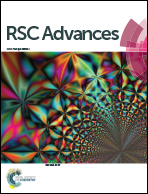Syntheses, structures and properties of five entangled coordination polymers constructed with trigonal N-donor ligands†
Abstract
Based on the mixed-ligand system, five new entangled coordination polymers have been synthesized, namely, [Co1.5(1,3-bdc)1.5(tib)(H2O)] (1), [Ni(1,3-bdc)(tib)(H2O)2]·0.5H2O (2), [Cu(Hbtc)(Htpim)] (3), [Co(bpndc)(pytpy)(H2O)]·0.5H2O (4), and [Ni(bpndc)(pytpy)(H2O)]·0.5H2O (5), (1,3-bdc = 1,3-benzenedicarboxylate, btc = 1,3,5-benzenetricarboxylate, bpndc = 4,4′-benzophenone dicarboxylate, tib = 1,3,5-tris(1-imidazolyl)benzene, Htpim = 2,4,5-tri(4-pyridyl)-imidazole, pytpy = 2,4,6-tris(4-pyridyl)pyridine). Their structures were determined by single-crystal X-ray diffraction analyses and further characterized by elemental analyses, IR spectroscopy and TG analyses. Compound 1 exhibits a new trinodal (3,4,4)-connected 3D self-penetrating framework with (83)2(63.82.9)2(84.9.10) topology. Compound 2 displays an interesting 2D → 3D polythreading framework constructed from sidearm-containing 2D 63-hcb nets. Compound 3 exhibits an unusual (2D → 3D) entangled array with the coexistence of polythreading and interdigitation self-assembled from sidearm-containing 2D double-edged nets. Compounds 4 and 5 both show an intriguing 3-fold interpenetrated PtS-type (4,4)-connected 3D framework containing meso-helices. In addition, the magnetic properties of compounds 1–5 have been investigated in the temperature range 2–300 K.


 Please wait while we load your content...
Please wait while we load your content...